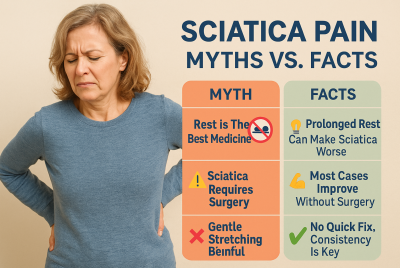Sciatica Nerve Pain Treatment
Discover effective sciatica nerve pain treatment strategies. From exercises to holistic approaches, our guide provides insights for relief. Say goodbye to sciatic discomfort today. Dealing with sciatica nerve pain can be both challenging and debilitating. As someone passionate about sciatica health and eager to provide helpful suggestions, I understand the importance of finding effective treatments. In this sciatica nerve pain treatment article, we’ll delve into various aspects of sciatica, from understanding its symptoms to exploring holistic approaches and future trends in treatment. Let’s embark on a journey to alleviate sciatic discomfort and enhance the quality of life.
Understanding Sciatica
Sciatica, characterized by pain along the sciatic nerve, often manifests as shooting pain down the leg. It commonly results from compression or irritation of the nerve roots in the lower spine. The prevalence of sciatica underscores the need for comprehensive information on effective treatments.
Prevalence and Causes of Sciatica
Sciatica is not an isolated issue; it affects millions worldwide. Understanding the root causes, such as herniated discs or spinal stenosis, is crucial for tailoring effective treatment plans.
Impact on Daily Life
The repercussions of sciatic pain extend beyond physical discomfort. Daily activities become arduous, impacting work, relationships, and overall well-being. This emphasizes the urgency of finding suitable remedies.
Symptoms of Sciatica
Recognizing the symptoms is the first step in addressing sciatic pain. Sharp shooting pain, numbness, tingling sensations, and weakness in the legs are telltale signs that should not be ignored.
Sharp Shooting Pain
The hallmark of sciatica, sharp shooting pain, can be debilitating. Identifying the triggers and implementing targeted interventions are essential for pain management.
Numbness and Tingling
Numbness and tingling along the sciatic nerve pathway are indicators of nerve compression. Exploring therapies that alleviate pressure on the nerve is key to relieving these sensations.
Weakness in Legs
Persistent weakness in the legs is not merely a physical challenge but also a potential sign of nerve damage. Tailored exercises and therapies can contribute to strength restoration.
Radiating Pain
Understanding the radiating nature of sciatic pain is vital. Pinpointing the origin and adopting targeted approaches can mitigate the intensity and frequency of radiating discomfort.
Diagnosing Sciatica
A proper diagnosis sets the stage for effective treatment. Physical examinations, imaging tests, and early detection play pivotal roles in managing sciatica.
Physical Examination
Healthcare professionals conduct thorough physical examinations to pinpoint the source of sciatic pain. A comprehensive evaluation aids in devising personalized treatment plans.
Imaging Tests
From X-rays to MRIs, imaging tests offer insights into the structural issues contributing to sciatica. Early diagnosis through these tests enhances the effectiveness of subsequent interventions.
Importance of Early Diagnosis
Timely identification of sciatica allows for proactive management, preventing the progression of symptoms and potential complications. Early intervention is a key component of successful treatment.
Fast Sciatica Nerve Pain Treatment
Conventional Treatments
Conventional approaches include pain medications, physical therapy, steroid injections, and surgical options. Understanding the pros and cons of each is crucial for informed decision-making.
Pain Medications
Prescription and over-the-counter medications offer temporary relief. However, long-term dependence raises concerns about side effects and the need for alternative strategies.
Physical Therapy
Tailored exercises and stretches prescribed by physical therapists aim to alleviate sciatic pain. Regular sessions contribute not only to pain reduction but also to long-term prevention.
Steroid Injections
Invasive yet effective steroid injections target inflammation, providing relief from sciatic pain. Considering the potential risks and benefits is essential when exploring this option.
Surgical Options
Surgery becomes a consideration in severe cases. Disc decompression or discectomy may be recommended, but the decision requires careful evaluation of individual circumstances.
Holistic Approaches
Holistic approaches emphasize a comprehensive view of sciatica treatment. Yoga, stretching, chiropractic care, and acupuncture offer non-invasive alternatives with promising results.
Yoga and Stretching
Gentle yoga poses and targeted stretches can alleviate tension in the lower back, reducing sciatic pain. Incorporating these practices into daily routines promotes flexibility and overall well-being.
Chiropractic Care
Spinal adjustments by chiropractors aim to realign the spine, addressing the root causes of sciatica. Regular chiropractic sessions can contribute to long-term relief.
Acupuncture
The ancient practice of acupuncture involves inserting thin needles into specific points to stimulate energy flow. Studies suggest its efficacy in reducing sciatic pain and improving overall mobility.
Lifestyle Changes
Simple lifestyle adjustments, such as ergonomic improvements and posture awareness, play a significant role in preventing and managing sciatic discomfort.
Sciatica-Friendly Exercises
Regular exercise is a cornerstone of sciatica management. Low-impact cardio, core-strengthening exercises, and sciatic nerve stretches enhance overall physical well-being.
Low-Impact Cardio
Engaging in activities like swimming or cycling reduces the impact on joints while promoting cardiovascular health. These exercises are particularly beneficial for individuals with sciatica.
Core Strengthening
A strong core provides stability and support to the spine. Targeted exercises that strengthen abdominal and back muscles contribute to better posture and reduced sciatic pain.
Sciatic Nerve Stretches
Specific stretches that target the sciatic nerve pathway enhance flexibility and alleviate tension. Incorporating these stretches into daily routines can be a game-changer for individuals dealing with sciatica.
Nutritional Support
Nutrition plays a crucial role in managing inflammation and promoting overall health. An anti-inflammatory diet, adequate hydration, and targeted supplements contribute to sciatic pain relief.
Anti-Inflammatory Diet
Foods rich in antioxidants and anti-inflammatory properties, such as fatty fish and leafy greens, form the basis of an anti-inflammatory diet. Dietary choices can impact the body’s response to sciatic pain.
Importance of Hydration
Adequate hydration supports spinal health by maintaining the fluid balance in discs. Staying hydrated is a simple yet effective way to contribute to overall sciatica management.
Supplements for Sciatica Relief
Certain supplements, such as turmeric and omega-3 fatty acids, possess anti-inflammatory properties that may aid in reducing sciatic pain. Consulting with a healthcare professional is essential before incorporating supplements.
Mind-Body Connection
The mind-body connection is integral to managing chronic pain. Stress reduction techniques, meditation, and mindfulness practices contribute to a holistic approach to sciatica treatment.
Stress Reduction Techniques
Chronic pain and stress often go hand in hand. Techniques like deep breathing, progressive muscle relaxation, and biofeedback can alleviate stress and, consequently, reduce sciatic discomfort.
Meditation and Mindfulness
Mindfulness practices, including meditation and mindful awareness, help individuals develop a positive mindset and cope with the challenges of living with sciatica.
Psychological Impact of Chronic Pain
Acknowledging and addressing the psychological impact of chronic pain is essential. Support from mental health professionals can complement physical interventions for a well-rounded approach.
Preventive Measures
Preventive measures are key to minimizing the recurrence of sciatic pain. Ergonomic practices, a regular exercise routine, and proper lifting techniques contribute to long-term well-being.
Ergonomic Practices
Maintaining proper posture and using ergonomic furniture is crucial in preventing strain on the lower back. Simple adjustments in the workplace and at home can make a significant difference.
Regular Exercise Routine
Establishing a consistent exercise routine that includes a variety of activities promotes overall health and resilience against sciatic pain. A balanced approach is essential for sustained benefits.
Proper Lifting Techniques
Adopting proper lifting techniques protects the spine from unnecessary strain. Education on lifting mechanics is essential for individuals prone to sciatic pain.
Personal Success Stories
Real-life success stories provide inspiration and motivation. Sharing experiences of overcoming sciatica challenges can offer hope and valuable insights to others on a similar journey.
Real-Life Experiences
Individuals who have successfully managed sciatica share their personal journeys. From the initial struggles to triumphs, these stories resonate with those seeking solace and guidance.
Overcoming Sciatica Challenges
Highlighting the challenges and obstacles faced during the sciatica journey underscores the resilience of individuals who have overcome them. These narratives offer practical tips for navigating difficulties.
Motivation for Others
Motivational anecdotes serve as a reminder that improvement is possible. Encouraging others to stay committed to their treatment plans fosters a sense of community among those dealing with sciatica.
Choosing the Right Treatment Plan
Selecting the right treatment plan requires consultation with healthcare professionals, considering an individualized approach, and weighing the long-term effects of each option.
Consultation with Healthcare Professionals
Expert guidance is invaluable in crafting a personalized treatment plan. Consulting with healthcare professionals ensures a thorough understanding of individual needs and circumstances.
Individualized Approach
Recognizing that each case of sciatica is unique, an individualized approach to treatment allows for targeted interventions that address specific contributing factors.
Considering Long-Term Effects
Understanding the potential long-term effects of different treatment options is crucial. Balancing short-term relief with the sustainability of results guides informed decision-making.
Alternative Therapies
Exploring alternative therapies, such as massage therapy and herbal remedies, complements conventional approaches and provides additional avenues for sciatica relief.
Massage Therapy
Targeted massage techniques can alleviate muscle tension and promote circulation, contributing to reduced sciatic pain. Regular sessions offer both physical and mental benefits.
Herbal Remedies
Certain herbs, such as Devil’s Claw and White Willow Bark, are believed to have anti-inflammatory properties. Integrating herbal remedies into the treatment plan should be done under professional supervision.
Importance of Professional Guidance
While alternative therapies can be beneficial, professional guidance ensures safe and effective integration into the overall sciatica treatment strategy.
Sciatica in Different Age Groups
Understanding how sciatica manifests in different age groups provides insights into tailored interventions and considerations for each demographic.
Sciatica in Young Adults
Young adults dealing with sciatica may face unique challenges. Lifestyle adjustments, early intervention, and preventive measures are key components of managing sciatic pain in this age group.
Sciatica in Middle-Aged Individuals
As individuals enter middle age, the risk of sciatica may increase. Balancing work, family, and health becomes crucial, emphasizing the need for holistic approaches to sciatica management.
Sciatica in Seniors
Seniors dealing with sciatica may have additional health considerations. Gentle exercises, nutritional support, and regular check-ups contribute to maintaining overall well-being in this demographic.
Future Trends in Sciatica Treatment
Advancements in medical research and technological innovations are shaping the future of sciatica treatment. Integrative healthcare approaches offer hope for more effective and personalized interventions.
Advancements in Medical Research
Ongoing research into the mechanisms of sciatic pain and potential breakthroughs in medical treatments hold promise for improved outcomes. Staying informed about emerging research is essential for those navigating sciatica.
Technological Innovations
From wearable devices to telemedicine, technological innovations are enhancing the accessibility of sciatica care. Exploring these tools can empower individuals to manage their condition effectively.
Integrative Healthcare
The future of sciatica treatment lies in integrative healthcare models that combine conventional and alternative approaches. Collaborative efforts between healthcare professionals offer a holistic and patient-centered approach.
FAQs About Sciatica Nerve Pain Treatment
Can sciatica be completely cured?
While a complete cure may not be guaranteed, effective management and relief from symptoms are achievable through a comprehensive and personalized treatment plan.
Are alternative therapies like acupuncture safe for sciatica treatment?
When administered by trained professionals, alternative therapies like acupuncture can be safe and beneficial as part of a holistic sciatica treatment approach.
How important is early diagnosis in managing sciatica?
Early diagnosis is crucial in managing sciatica, as it enables timely intervention and tailored treatment plans. Identifying sciatic nerve issues promptly ensures that individuals receive effective care, minimizes pain, and prevents long-term complications, contributing to a quicker and more successful recovery.
Are there specific foods that worsen sciatica pain?
Certain foods can exacerbate sciatica pain. Consuming inflammatory substances like processed foods and high-sugar items may intensify symptoms. Being mindful of dietary choices and opting for an anti-inflammatory diet can be pivotal in managing and alleviating sciatic nerve pain.
Can exercise worsen sciatica symptoms?
Improperly performed exercises can worsen sciatica symptoms. Engaging in activities without professional guidance may lead to aggravation. It is essential to consult with healthcare experts to receive personalized exercise recommendations that effectively alleviate sciatica discomfort without exacerbating the condition.
Sciatica Nerve Pain Treatment – Conclusion
Navigating sciatica nerve pain involves a multifaceted approach that addresses not only the physical symptoms but also the emotional and psychological aspects of chronic pain. By incorporating a combination of conventional treatments, holistic approaches, and preventive measures, individuals can significantly improve their quality of life and manage sciatic pain effectively.
Disclaimer
Please note that the information provided in this article is for informational purposes only and should not replace professional medical advice. If you’re experiencing sciatica pain or any health concerns, it’s advisable to consult a healthcare professional for proper diagnosis and treatment.






